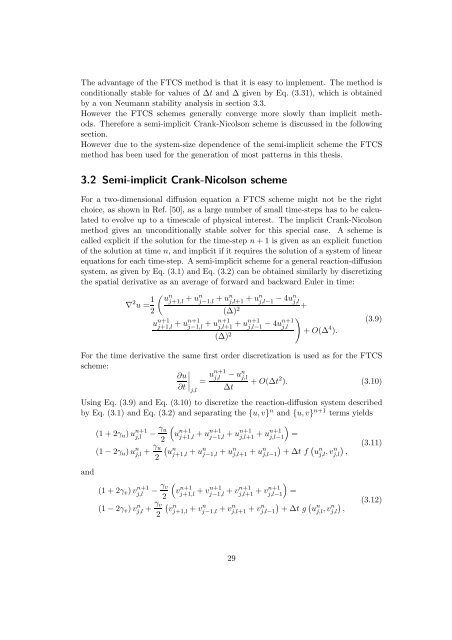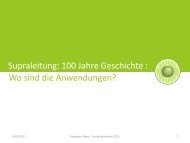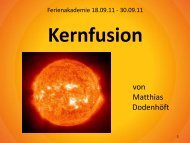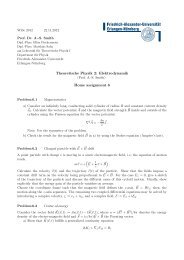Morphology of Experimental and Simulated Turing Patterns
Morphology of Experimental and Simulated Turing Patterns
Morphology of Experimental and Simulated Turing Patterns
You also want an ePaper? Increase the reach of your titles
YUMPU automatically turns print PDFs into web optimized ePapers that Google loves.
The advantage <strong>of</strong> the FTCS method is that it is easy to implement. The method isconditionally stable for values <strong>of</strong> ∆t <strong>and</strong> ∆ given by Eq. (3.31), which is obtainedby a von Neumann stability analysis in section 3.3.However the FTCS schemes generally converge more slowly than implicit methods.Therefore a semi-implicit Crank-Nicolson scheme is discussed in the followingsection.However due to the system-size dependence <strong>of</strong> the semi-implicit scheme the FTCSmethod has been used for the generation <strong>of</strong> most patterns in this thesis.3.2 Semi-implicit Crank-Nicolson schemeFor a two-dimensional diffusion equation a FTCS scheme might not be the rightchoice, as shown in Ref. [50], as a large number <strong>of</strong> small time-steps has to be calculatedto evolve up to a timescale <strong>of</strong> physical interest. The implicit Crank-Nicolsonmethod gives an unconditionally stable solver for this special case. A scheme iscalled explicit if the solution for the time-step n + 1 is given as an explicit function<strong>of</strong> the solution at time n, <strong>and</strong> implicit if it requires the solution <strong>of</strong> a system <strong>of</strong> linearequations for each time-step. A semi-implicit scheme for a general reaction-diffusionsystem, as given by Eq. (3.1) <strong>and</strong> Eq. (3.2) can be obtained similarly by discretizingthe spatial derivative as an average <strong>of</strong> forward <strong>and</strong> backward Euler in time:∇ 2 u = 1 2( unj+1,l+ u n j−1,l + un j,l+1 + un j,l−1 − 4un j,l(∆) 2 +u n+1j+1,l + un+1 j−1,l + un+1 j,l+1 + un+1 j,l−1 − )4un+1 j,l(∆) 2 + O(∆ 4 ).(3.9)For the time derivative the same first order discretization is used as for the FTCSscheme:∂u∂t ∣ = un+1 j,l− u n j,l+ O(∆t 2 ). (3.10)j,l∆tUsing Eq. (3.9) <strong>and</strong> Eq. (3.10) to discretize the reaction-diffusion system describedby Eq. (3.1) <strong>and</strong> Eq. (3.2) <strong>and</strong> separating the {u,v} n <strong>and</strong> {u,v} n+1 terms yields(1 + 2γ u ) u n+1j,l− γ ()uu n+12j+1,l + un+1 j−1,l + un+1 j,l+1 + un+1 j,l−1=(1 − 2γ u ) u n j,l + γ u(un2 j+1,l + u n j−1,l + un j,l+1 + ) ( (3.11)un j,l−1 + ∆t f unj,l ,vj,l) n ,<strong>and</strong>(1 + 2γ v ) v n+1j,l(1 − 2γ v ) v n j,l + γ v2− γ ()vv n+12j+1,l + vn+1 j−1,l + vn+1 j,l+1 + vn+1 j,l−1=(vnj+1,l + vj−1,l n + vn j,l+1 + ) ( (3.12)vn j,l−1 + ∆t g unj,l ,vj,l) n ,29






